The Ultimate Guide to Buying Sunglasses: Answering Your Top 15+ Questions
Ever found yourself standing in front of a massive wall of sunglasses, feeling completely overwhelmed? The confusing jargon (UV400, polarized, Category 3) and endless options can make what should be a simple purchase feel like a complex decision. And the big question always lingers: “Are expensive sunglasses really worth it?”
This guide is different. Instead of just listing products, we’ve designed it to answer the most common, real-world questions people ask about sunglasses, using data from actual Google searches. We’re cutting through the marketing hype to give you the facts you need.
By the end of this guide, you’ll be able to walk into any store (or browse any website) and confidently choose the perfect, high-quality pair of sunglasses for your needs and budget. No more guesswork, no more wasted money on pairs that don’t work for you.
UV vs. Polarized: What’s the Real Difference and Which is Better?
This is the #1 question people ask about sunglasses, and for good reason. These terms are often used interchangeably in marketing, but they’re completely different features that serve different purposes.
UV Protection: The Non-Negotiable Health Feature
UV (ultraviolet) light is invisible radiation from the sun that can seriously damage your eyes. Prolonged exposure to UV rays can lead to cataracts, macular degeneration, and even cancer of the eyelids and surrounding skin.
UV protection in sunglasses comes from a clear, invisible coating applied to the lens. This has nothing to do with how dark the lenses are or their color. Even clear lenses can have 100% UV protection.
Actionable Tip: Only buy sunglasses labeled “100% UVA/UVB Protection” or “UV400.” This is the single most important factor in choosing sunglasses.

Polarization: The “Comfort and Clarity” Feature
Think of polarization like venetian blinds for your eyes. It filters out the intense, horizontal glare that bounces off surfaces like water, roads, and snow. This reduces eye strain and improves visibility in bright conditions.
If you’ve ever driven on a sunny day after rain and been blinded by the glare off the wet road, or tried to see into water while fishing or boating, you’ve experienced the problem polarized lenses solve.
Polarization is about visual comfort and clarity, not eye health. A polarized lens does not automatically have UV protection (though most quality ones do).
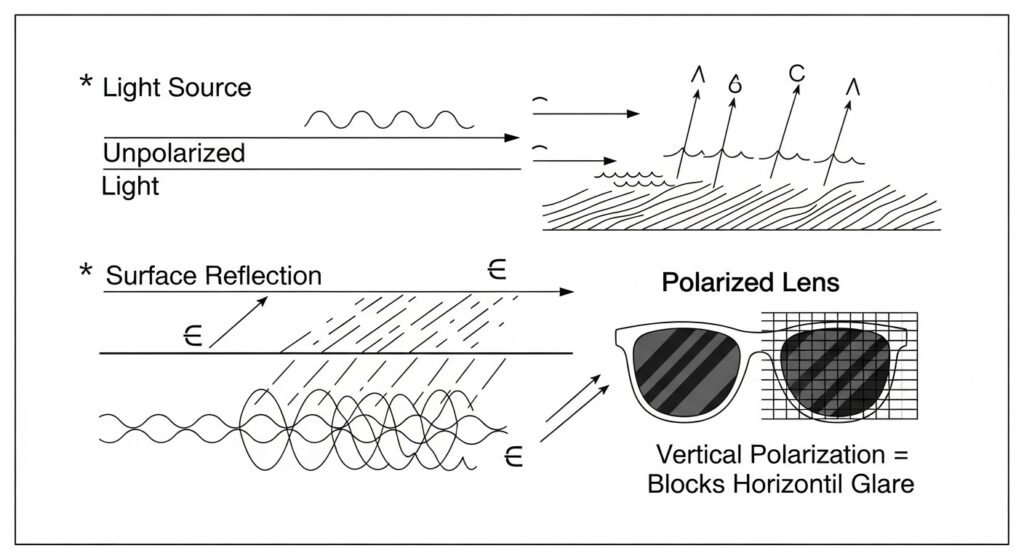
The Verdict: Do You Need Both?
You need UV protection. You want polarization for certain activities.
The best sunglasses have both features. But if you’re on a budget, UV protection is the absolute priority for eye health. Never compromise on this.
Looking for sunglasses that offer both 100% UV protection and polarization? These top-rated options provide excellent protection while reducing glare:
UV Protection
- Protects eye health
- Prevents cataracts and macular degeneration
- Invisible coating
- Non-negotiable feature
Polarization
- Improves visual comfort
- Reduces glare from reflective surfaces
- Enhances contrast and clarity
- Desirable but optional feature
How to Tell if Sunglasses are High-Quality (and if Price Matters)
With sunglasses ranging from $5 to $500+, it’s natural to wonder if you’re paying for quality or just a brand name. Let’s break down what actually matters.
It’s All in the Lenses: What Makes a “Good” Lens?
Optical Clarity: Hold the sunglasses at arm’s length and look through them at a straight line (like a door frame). Move the glasses slowly from side to side. If the line appears to wiggle or distort, the lenses have poor optical quality, which can cause headaches and eye strain.
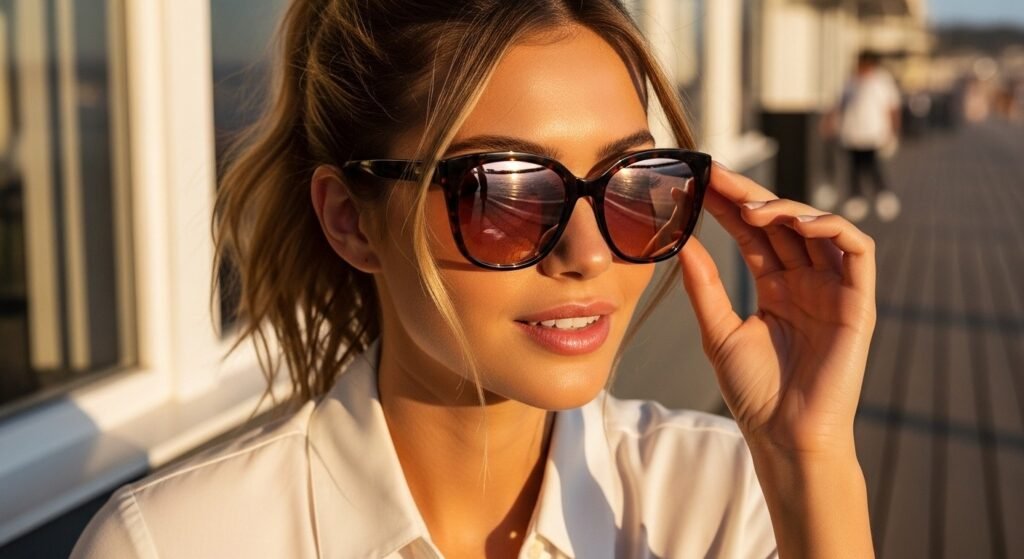
Lens Material: There are three main types:
- Polycarbonate: Impact-resistant and lightweight. Great for sports and active use (used by brands like Oakley).
- CR-39 Plastic: Good optical clarity at a reasonable price. Common in mid-range sunglasses.
- Glass: Best clarity and scratch resistance, but heavier. Used in classic Ray-Bans and premium brands.
Coatings: Quality sunglasses often include anti-scratch coatings and oleophobic (anti-smudge) treatments that keep lenses cleaner and extend their life.
Don’t Forget the Frame: Signs of Quality Construction
Material: Cheap plastic frames feel light and flimsy. Quality acetate frames have a substantial, heavier feel. Metal frames should have smooth finishes without rough edges.
Hinges: Look for sturdy, multi-barrel hinges (5 or 7 barrels) rather than flimsy single-barrel designs. Quality hinges move smoothly without wobbling.
Overall Feel: Quality sunglasses feel solid when you open and close them. They shouldn’t creak or feel like they might snap with normal handling.
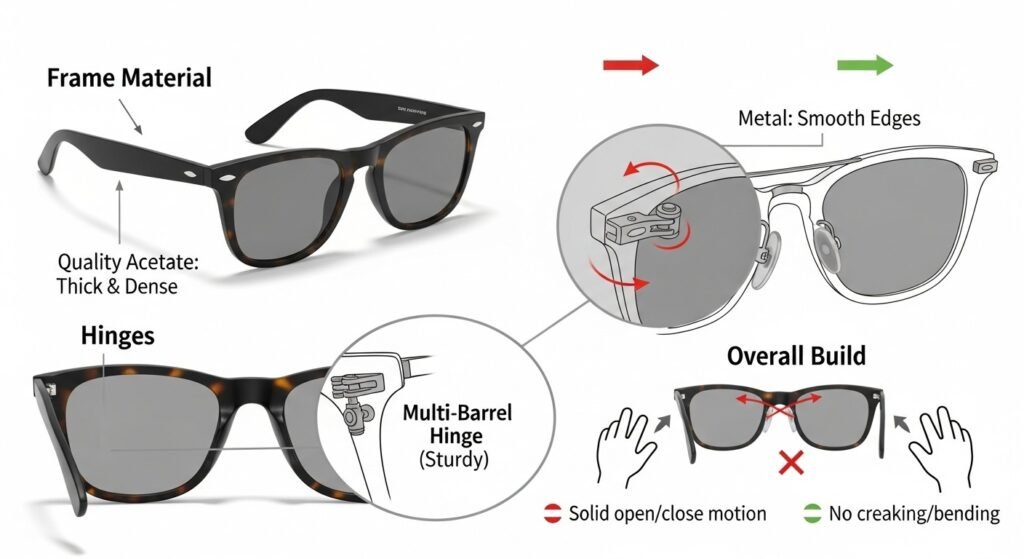
Answering the Big Question: Why are Cheap Sunglasses Best Avoided?
The biggest danger with cheap sunglasses isn’t just that they’ll break quickly. It’s that they may be dark but offer zero UV protection. This is actually worse than wearing no sunglasses at all, as the darkness causes your pupils to dilate, letting in more harmful UV light.
Poor optical quality in cheap lenses can also cause headaches, eye strain, and even dizziness with prolonged wear.
So, Are Expensive Sunglasses Really Better?
The honest answer: Not always for protection, but often for clarity, durability, and comfort.
You’re paying for better materials, research and development (like Oakley’s Prizm or Maui Jim’s PolarizedPlus2 lenses), brand name, and warranty. A $30 pair with proper UV protection is better for your eyes than a $300 pair without it.
The sweet spot for most people is in the $50-150 range, where you get good protection, decent optical quality, and reasonable durability without paying primarily for the brand name.
Looking for quality sunglasses that won’t break the bank? These options offer excellent UV protection and durability at reasonable prices:
How to Pick Out the Perfect Sunglasses: A 5-Step Checklist
Use this simple checklist to ensure you’re getting the right pair every time.
- Verify 100% UV Protection. This is non-negotiable. Look for “UV400” or “100% UV protection” on the label or description.
- Consider Polarization. Will you be driving, fishing, or near water often? If yes, polarized lenses are worth the extra cost for reduced glare and better visibility.
- Check the Lens Category. Category 3 (blocks 82-92% of light) is ideal for general use in strong sunlight. Category 2 is for moderate sun, while Category 4 (blocks up to 97%) is for extreme conditions like mountaineering (not suitable for driving).
- Assess the Fit & Coverage. Sunglasses should ideally cover your eyebrows or follow the line of your brow for maximum protection. The frame should not be wider than your face, and the lenses should cover your eyes completely without touching your cheeks.
- Test for Quality and Comfort. Do the “straight line test” for lens quality. Check that the sunglasses feel comfortable on your nose and behind your ears, even after wearing them for 15-20 minutes.
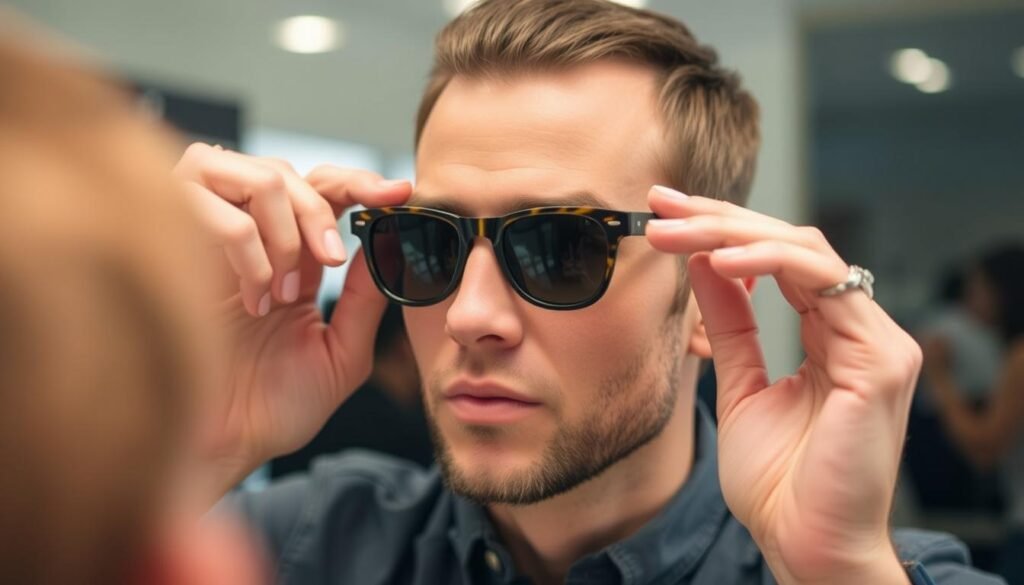
What Does Category 3 Sunglasses Mean?
Sunglasses are categorized by how much light they block:
| Category | Light Blocked | Best For | Driving Safe? |
| Category 0-1 | 20-57% | Cloudy days, indoor/outdoor use | Yes |
| Category 2 | 57-82% | Medium sun, urban environments | Yes |
| Category 3 | 82-92% | Bright sun, beach, general use | Yes |
| Category 4 | 92-97% | Extreme light (mountains, snow) | No |
Should Sunglasses Cover Eyebrows?
Ideally, yes. Sunglasses that cover or follow the line of your eyebrows provide better protection from light entering from above. This design also blocks UV rays that would otherwise reach the delicate skin around your eyes.
However, the most important factor is that they fully cover your eyes and fit comfortably without pressing on your cheeks or temples.
What Are the Three Numbers on Sunglasses?
Those numbers (like 52-18-140) refer to the frame dimensions in millimeters:
- First number (52): Lens width – the horizontal width of each lens
- Second number (18): Bridge width – the distance between the lenses
- Third number (140): Temple length – the length of the arms that go over your ears
These measurements are extremely helpful when buying sunglasses online, as they allow you to compare sizes with pairs you already own and find a comfortable fit.
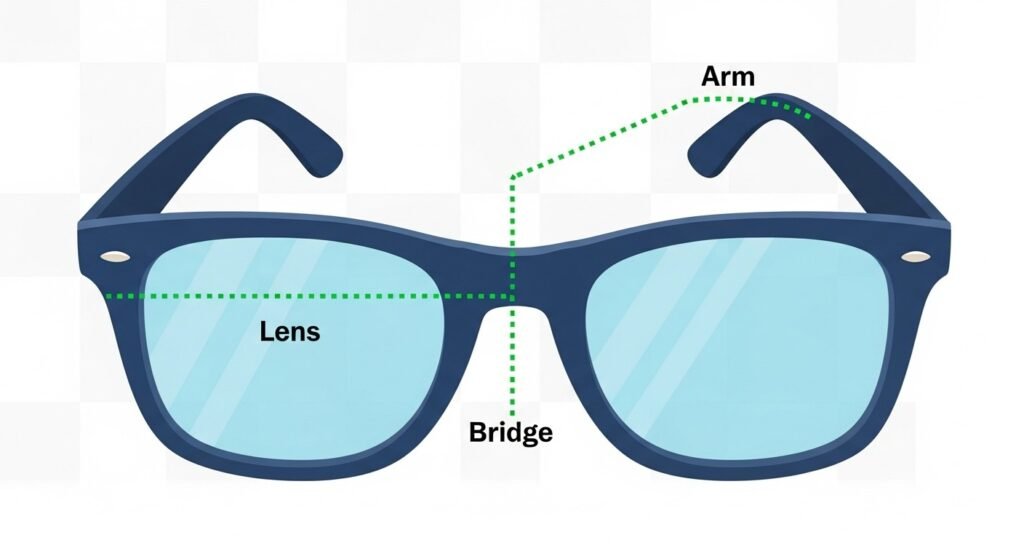
Ready to find your perfect pair? These highly-rated sunglasses check all the boxes for protection, quality, and style:
Ray-Ban vs. Oakley vs. Maui Jim: Understanding the Big Brands
Not all sunglass brands are created equal. Each has its strengths and specialties that make them better suited for different needs and lifestyles.

Ray-Ban: The Timeless Classic
Ray-Ban has been making iconic sunglasses since 1937, with styles like the Aviator and Wayfarer becoming cultural landmarks.
- Known for: Timeless style, quality glass lenses, cultural icon status
- Best for: Everyday wear, classic fashion, durability
- Price range: $100-$250
- Signature models: Aviator, Wayfarer, Clubmaster
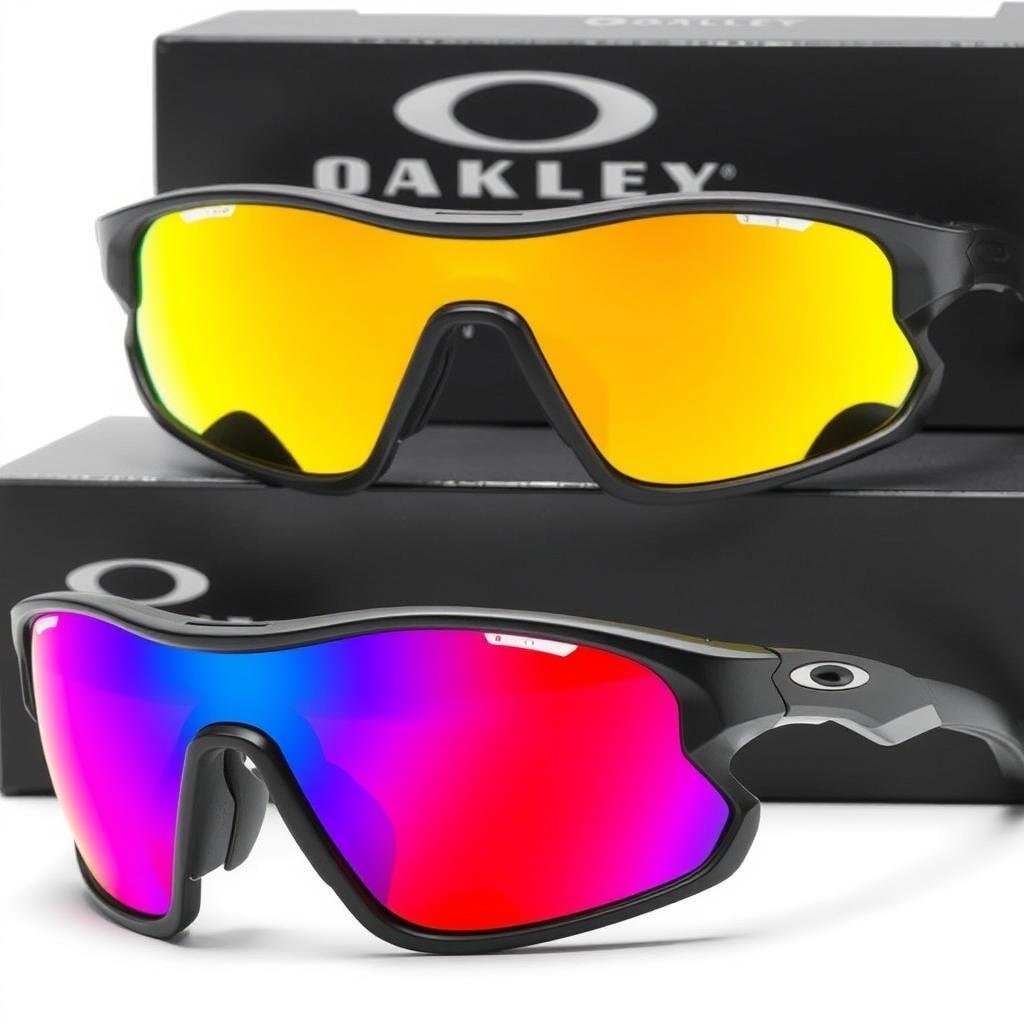
Oakley: The Sport & Performance Leader
Oakley revolutionized sports eyewear with their focus on performance, durability, and optical innovation.
- Known for: Sport-specific lenses, impact resistance, innovative technology
- Best for: Athletes, outdoor enthusiasts, active lifestyles
- Price range: $100-$300
- Signature technology: Prizm lenses for enhanced contrast
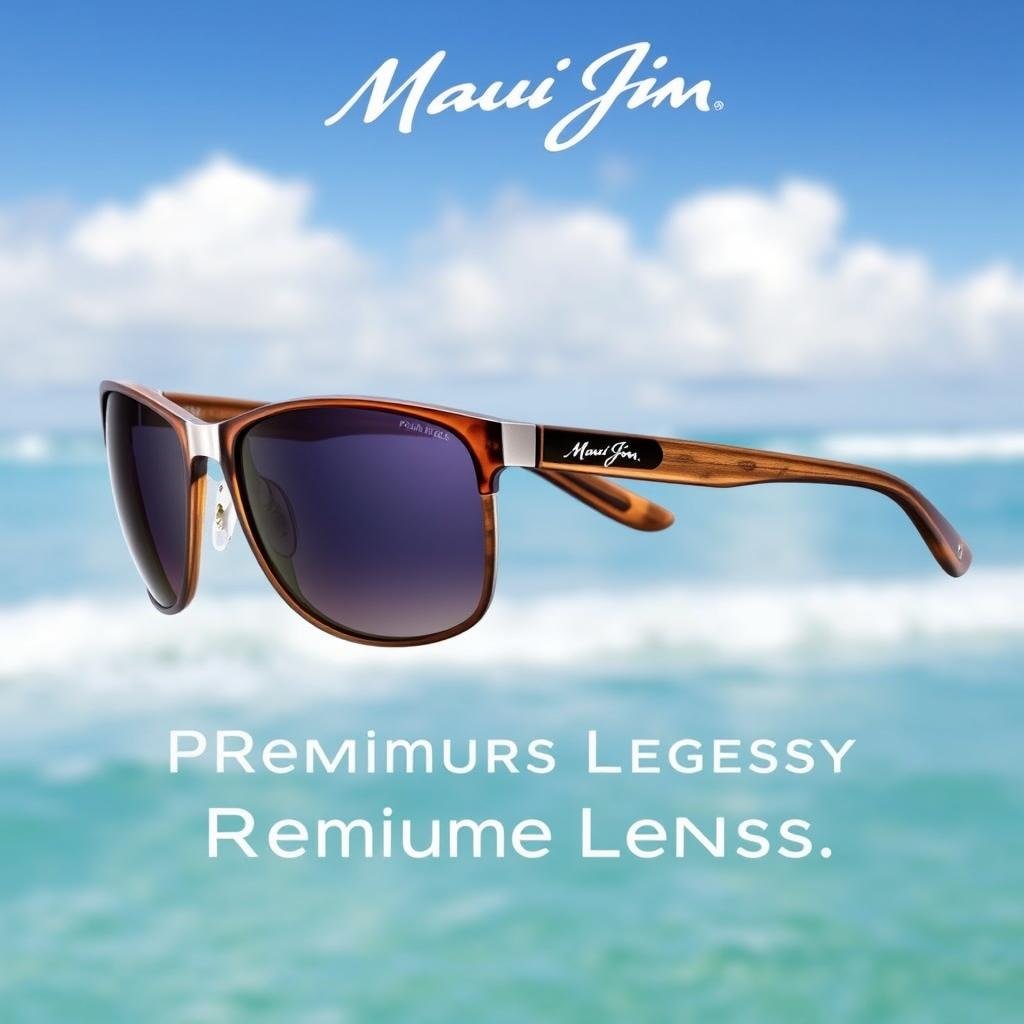
Maui Jim: The Premium Polarized Lens Expert
Maui Jim started on the beaches of Hawaii and specializes in the highest quality polarized lenses available.
- Known for: Superior polarization, color enhancement, clarity
- Best for: Water activities, driving, premium lens quality
- Price range: $200-$400
- Signature technology: PolarizedPlus2® lens technology
Other Notable Brands to Know
- Costa Del Mar: Excellent for fishing and water sports with specialized lens technology
- Persol: Italian craftsmanship with premium materials and timeless designs
- Smith: Great for outdoor activities with ChromaPop lens technology
- WearMe Pro: Renowned for their patented anti-slip nose pads, ensuring a secure and comfortable fit all day long.
- Goodr: Budget-friendly performance sunglasses popular with runners
- Torry Debt: Recognized for their ultra-lightweight, unbreakable frames designed for extreme durability and all-day comfort.
Is Oakley Owned by Lenscrafters?
No, but you’re close. Both Oakley and LensCrafters are owned by the same parent company, EssilorLuxottica. This Italian-French eyewear conglomerate owns most major eyewear brands including Ray-Ban, Oakley, Persol, Oliver Peoples, and retailers like Sunglass Hut and LensCrafters.
Are Oakley Sunglasses Worth It?
If you’re active or need performance eyewear, yes. Oakley invests heavily in research and development, resulting in features like:
- Impact-resistant lenses that exceed safety standards
- Prizm lens technology that enhances contrast for specific activities
- Durable frame materials designed for active use
- Sport-specific designs for optimal performance
For casual wear, you might not need all these features, but for sports and active lifestyles, the performance benefits can justify the price.
Ready to invest in a premium pair from one of these top brands? Find the best deals here:
What are the Best Sunglasses for Seniors?
Eye protection becomes even more critical with age, as the risk of conditions like cataracts and age-related macular degeneration increases. Here’s what seniors should look for in sunglasses.
Should Older People Wear Sunglasses?
Absolutely. As we age, our eyes become more vulnerable to UV damage. The lens of the eye naturally yellows and the pupil size decreases, but this doesn’t provide adequate protection. In fact, studies show that proper sunglasses can slow the progression of cataracts and reduce the risk of macular degeneration.
What Glasses Look Best on an Older Face?
The best sunglasses for seniors combine style, comfort, and functionality:
- Lightweight frames reduce pressure on the nose and ears
- Larger lenses provide maximum coverage and protection
- Wraparound styles block light from entering at the sides
- Polarized lenses reduce glare, which can be more bothersome for aging eyes
- Styles that lift the face, like subtle cat-eye or upswept square frames, can be flattering

Recommended Features
- 100% UV protection (non-negotiable)
- Polarized lenses to reduce glare
- Lightweight, comfortable frames
- Spring hinges for easier handling
- Larger lenses for better coverage
Features to Avoid
- Heavy frames that cause discomfort
- Very small lenses with minimal coverage
- Overly dark lenses that impair vision
- Complicated folding mechanisms
- Non-polarized lenses if driving regularly
Looking for the perfect sunglasses for seniors? These options combine protection, comfort, and style:
Shop Senior-Friendly Sunglasses
Frequently Asked Questions About Buying Sunglasses
Ready to Find Your Perfect Pair of Sunglasses?
Finding the right sunglasses doesn’t have to be complicated. Focus on the “Holy Trinity” of sunglass shopping: 100% UV Protection, a High-Quality Lens, and a Comfortable Fit. Everything else—style, brand, special features—is secondary to these core requirements.
Armed with the knowledge from this guide, you’re now a savvy sunglasses shopper. You understand what matters for protection, what’s worth paying extra for, and how to spot quality when you see it.
Remember: your perfect pair is out there. It’s the one that protects your eyes, feels comfortable all day, and makes you feel confident when you wear it.
Explore Our Top Picks
Ready to find your perfect pair? Browse our curated selection of top-rated sunglasses for every budget, style, and need:
